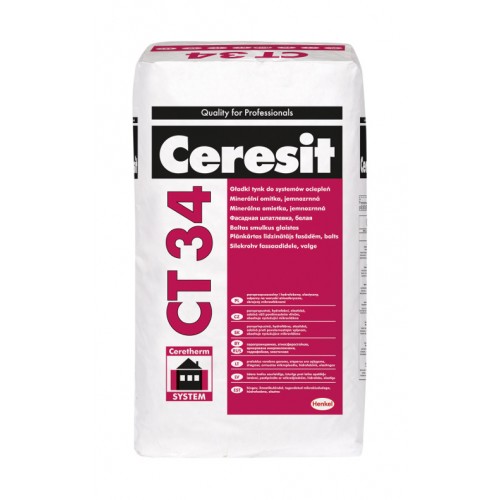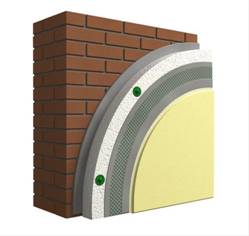Get Ready for Ceresit CT 34 Smooth Mineral Render

Everything You Need for an Insulated Render System
If you are considering on remodelling your façade, now would be a great time to consider taking everything a step further and choosing a system that will provide both functionality and aesthetics. Namely, it is very important to try to combine these two things since such investment can pay itself of in years to come. Carefully chosen components of one external wall insulation system can not only upgrade the thermal and acoustic performance of the building envelope but also prolong the life span of the building and improve its appearance, which is equally important. Well, in order of making your life easier, we are here to present one such system and help you get to know Ceresit CT 34 smooth mineral render, as its integral part.
Ceresit CT 34 Render Presentation
Firstly, you need to know a thing or two about the Ceresit CT 34 mineral render. It is a white, flexible and fibre reinforced mineral render used as a part of external thermal insulation systems for smooth surfaces, applied both internally and externally. The render is very easy to apply since it offers good adhesion and is resistant to different weather conditions, which is particularly important if the render is added to external surfaces. Apart from its main use as a part of external insulation systems, it can also be used to repair traditional plasters both inside and out (please note that it can be applied in very thin layers), as well as to smooth the plaster surfaces or fill deep looses.
Prior to moving onto installing the entire system which includes the CT 34 smooth render, it is important to keep a few things in mind regarding the preparation, application and storage of the render. Please note that it can be stored for 12 months if stored in dry conditions and in original packing. The render is prepared by mixing with some clean water and stirred with a mixer drill until it becomes smooth and lumps free. In order of reaching required density, small amounts of water can be subsequently added. Make sure to apply the render on dry conditions making sure that the temperature is adequate (optimally from 5 to 25º C). Finally, keep in mind that the render should not be applied to highly insulated walls, and the surface needs to be properly protected from too fast drying and rain for at least 24 hours.
External Insulated Render Systems
- The surface serving as the substrate for the system needs to be properly prepared prior to any work undertaken. Make sure that the surface is even, sound and free of any grease, dirt or contaminants. Potential moss and algae should be removed with a steel brush, treated with Ceresit CT 99 and left to dry. You can use Ceresit CR 61 to remove any hollow or loose render and to level any unevenness.
- If you are dealing with aerated concrete blocks or other similar high absorbency levels, it is important to prime the surface with CT 17 primer.
- Base profiles should be fixed at 300mm centres using adequate mechanical fixings. The base profile should be level, so use space washers on uneven surfaces to avoid profile deformation.
- In order of providing continuity facade bottom edge and the line, take special care when installing base profiles at internal and external edges. This can be done by cutting it to size without breaking the external vertical edge. Use connectors to connect joints between base profiles.
- Prior to adding suitable insulation in this insulated render system, it is time to prepare the bonding adhesive which is, upon preparation, trowlled in thin layer into the mineral wool board surface in order of providing better adhesion of the insulation material and the bonding surface.
- Adhesive mortar can be applied in two basic ways. The first one includes applying the mortar with a notched trowel, covering the entire surface of the insulation material. The other method includes applying the adhesive in 3-4cm strips along the edges and placing 8cm dabs in the middle of the board, at equal distances. Insulation boards are then placed firmly onto the wall, arranged in brick bond pattern and pressed starting from the bottom to the top. Press the boards onto the wall in order of ensuring equal distribution of the adhesive by using a straight edge or a steel trowel. Make sure to remove any excess mortar.
- The next step in applying this external insulated render system includes filling any gaps in insulation with insulation strips or alternatively low expanding polyurethane foam.
- It is then time to smooth the surface of the insulation boards by cutting any corner protruding edges with a saw and straight edge. Remaining unevenness can be removed by rasping the board edges.
- Follow the standard fixing patterns to add additional mechanical fixings. Use a drill bit to get to the substrate through the installed insulation board and insert specified Isofast insulation fixings.
- It is important to add reveal beads around window and door openings. Building, window and door corners should be protected by a wing mesh bead embedded in reinforcing mortar. Finally, movements in the building fabric are ensured by adding an expansion joint profile.
- Since door and window openings require additional corner reinforcements, add 350mm x 250mm reinforcement strips at an oblique angle to the opening.
- Prior to adding a finishing facade render, you can add a layer of CT 16 primer. Now it is time to add the presented render as the part of the render insulation system, which is applied to the surface by using a steel float. In order of achieving the required finish, you can move the float accordingly (vertical, horizontal or circular movement). In case you are planning on combining different types or colours of the renders, you can do so by using a masking tape.
Send us your EWI project requirements and we'll quote you on the whole EWI system, including our high quality Ceresit renders. Visit Insulation Shop and take a look at the products you can use for your insulation project.


















































































































